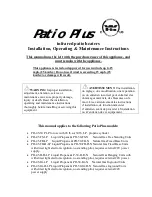
Rinnai
9
HOTFLO (HFE Series) Electric Storage Water Heater OIM
SAVE A SERVICE CALL
Check the items below before requesting a service� Service and parts charges may be incurred where it is found
that there is no fault with the water heater and the issue is related to the plumbing installation or is due to the failure
of water or electric supplies�
Insufficientornohotwater
Is the electricity supply
connected?
Check that the isolating switch marked “HOT WATER” or “WATER HEATER” at the
meter box is switched on� Check also that any isolating switches installed near the
water heater are switched on�
Check the fuse or circuit breaker marked “HOT WATER” or “WATER HEATER” at
the meter box� Repeated failure of fuse or tripping of circuit breaker indicates a fault
which must be investigated by an authorised trades person�
Is your unit a Twin Element
electric water heater?
A twin element model (non-simultaneous) must have a continuous electricity supply
to the top heating element� Check that this is the case�
Are you using more hot
water than you think?
Often it is not realized how much hot water is actually used� This applies especially
to showering� Review hot water usage, especially the time taken for showering, and
investigate the use of flow control valves or Water saving shower roses.
Are water heater valves
discharging excessively?
Refer to the section “Safety Devices” on page 7�
Thermostat settings?
Check the temperature of hot water delivered with a thermometer placed under the
closest outlet (usually the kitchen sink) on a non-tempered hot water line�
This test should be done early in the morning after overnight electrical boosting
before any hot water is used� The temperature of the water delivered should be at
least 55°C (allowing for heat losses in pipe work)�
If this is not the case, the temperature may need to be increased� Contact your
installer or Rinnai to discuss adjusting the thermostat�
No water from the hot tap? Restriction in the hot tap or failure of the cold water supply to the heater�
Check for water flow at the other hot taps and that the cold water isolation valve is
fully open�
HighElectricityBills
If you think your electricity
bill is too high, check for
these possibilities�
If, after investigating, and
you still require assistance
contact Rinnai.
You may be using more hot water than you think� This applies especially to showering�
Review hot water usage, especially the time taken for showering, and investigate the
use of flow control valves or ‘water saving’ shower roses. Investigate recent changes
to hot water usage patterns�
Water heater valves may be discharging excessively� Refer to the section “Safety
Devices” on page 7�
There may be hot water leakages in hot water pipes or taps� Have these checked and
rectified by a plumber.
There may have been changes in electricity tariffs since your last bill�
PERIODIC MAINTENANCE & SERVICING
If overflow tray and drain are fitted, it is the users responsibility to have these checked periodically to ensure there
are no blockages�
The user should operate the easing gear of the ECV and PTR valve (if fitted) every 6 months as described under
“Safety Devices” on page 7�
Rinnai service network personnel are fully trained and equipped� If your Rinnai appliance requires servicing contact
Rinnai as per the details on the back page of this manual� Rinnai recommends that this commercial appliance be
inspected and serviced by a qualified person every 12 months.
The ECV and PTR valve
MUSTBE
checked for performance or replaced by a qualified person at intervals not
exceeding 5 years or more frequently in areas where the water is classified as scaling water (refer to “Water
Quality” on page 8 for details)�
If the electric supply conduit to the water heater is damaged, it
MUSTBE
replaced by a qualified person in order
to avoid a hazard�
CARE & MAINTENANCE








































